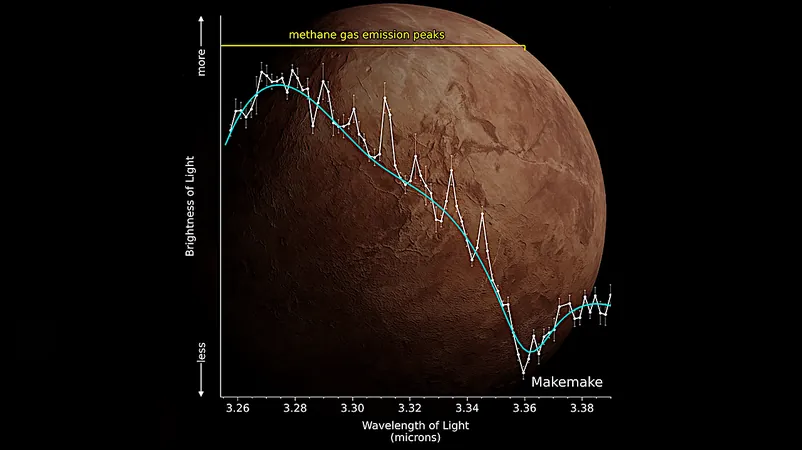
Groundbreaking Discovery: Methane Gas Found on Distant Makemake!
2025-09-11
Author: Wei Ling
Methane Gas Detected on Makemake!
In an exciting breakthrough for planetary science, a team from the Southwest Research Institute announced the first-ever detection of gas on the dwarf planet Makemake, using the remarkable capabilities of NASA’s James Webb Space Telescope (JWST). This extraordinary finding positions Makemake as only the second trans-Neptunian object, following Pluto, where gas has been confirmed, and it brings a thrilling new perspective on this distant icy world.
A Closer Look at Makemake's Methane Mystery
Dr. Silvia Protopapa, lead author of a study set for publication in *The Astrophysical Journal Letters*, stated, "Makemake is one of the largest and brightest icy worlds beyond Neptune, and its surface is dominated by frozen methane. The Webb telescope's insights reveal that methane isn’t just present in solid form but also exists in a gaseous state above the surface, making Makemake a genuinely dynamic entity in our solar system."
What Does This Mean for Makemake?
The methane's spectral emission observed has been ascribed to solar-excited fluorescence — sunlight interacting with methane molecules and causing them to re-emit energy. This could imply that Makemake has a thin atmosphere maintained by these gaseous emissions, much like Pluto, or that it may exhibit transient activities like comet-like sublimation or cryovolcanic eruptions. Both scenarios fit the current data surprisingly well, despite the challenges posed by the spectroscopic measurements.
Makemake: A Planet of Intrigue!
Measuring around 890 miles (1,430 km) in diameter — about two-thirds the size of Pluto — Makemake has established itself as an object of scientific fascination. Previous observations had suggested it might lack a substantial atmosphere, yet the possibility of a tenuous one remained. New infrared data, especially from JWST, revealed thermal anomalies and unique characteristics of its methane ice, hinting at the presence of localized hot spots and potential outgassing.
The Next Steps in Researching Methane on Makemake
Dr. Ian Wong, co-author of the study, underlined the importance of deciphering the volatile activities of Makemake. He stated, "While it's tempting to link various spectral and thermal anomalies, determining the underlying mechanisms is essential for interpreting these findings in a cohesive manner. Future Webb observations could clarify whether the methane originates from a sparse atmosphere or from dramatic plume-like outgassing."
Could Makemake Host an Atmosphere?
Explored further by Dr. Emmanuel Lellouch from the Paris Observatory, there’s a tantalizing possibility that Makemake could harbor a minuscule atmosphere supported by methane sublimation. Current models predict extremely low gas temperatures — around 40 Kelvin (-233 degrees Celsius) — and surface pressure merely a million times less than that of Pluto. Should this be verified, Makemake would join an elite group of celestial bodies in the outer solar system where surface-atmosphere exchanges are actively ongoing.
Eruptions and Plumes: The Wild Side of Makemake!
Moreover, Protopapa hinted at another thrilling possibility: the release of methane in plumes. This activity might occur at rates comparable to Saturn's moon Enceladus, far surpassing the minimal vapor observed at Ceres.
Your New Source for Cosmic Discoveries!
This groundbreaking research highlights the powerful link between JWST's observations and sophisticated spectral modeling, shedding light on the intriguing behaviors of volatile-rich surfaces in the trans-Neptunian region. The paper detailing this revolutionary discovery is titled "JWST Detection of Hydrocarbon Ices and Methane Gas on Makemake" and is set to be published soon, solidifying our understanding of this enigmatic dwarf planet.





 Brasil (PT)
Brasil (PT)
 Canada (EN)
Canada (EN)
 Chile (ES)
Chile (ES)
 Česko (CS)
Česko (CS)
 대한민국 (KO)
대한민국 (KO)
 España (ES)
España (ES)
 France (FR)
France (FR)
 Hong Kong (EN)
Hong Kong (EN)
 Italia (IT)
Italia (IT)
 日本 (JA)
日本 (JA)
 Magyarország (HU)
Magyarország (HU)
 Norge (NO)
Norge (NO)
 Polska (PL)
Polska (PL)
 Schweiz (DE)
Schweiz (DE)
 Singapore (EN)
Singapore (EN)
 Sverige (SV)
Sverige (SV)
 Suomi (FI)
Suomi (FI)
 Türkiye (TR)
Türkiye (TR)
 الإمارات العربية المتحدة (AR)
الإمارات العربية المتحدة (AR)